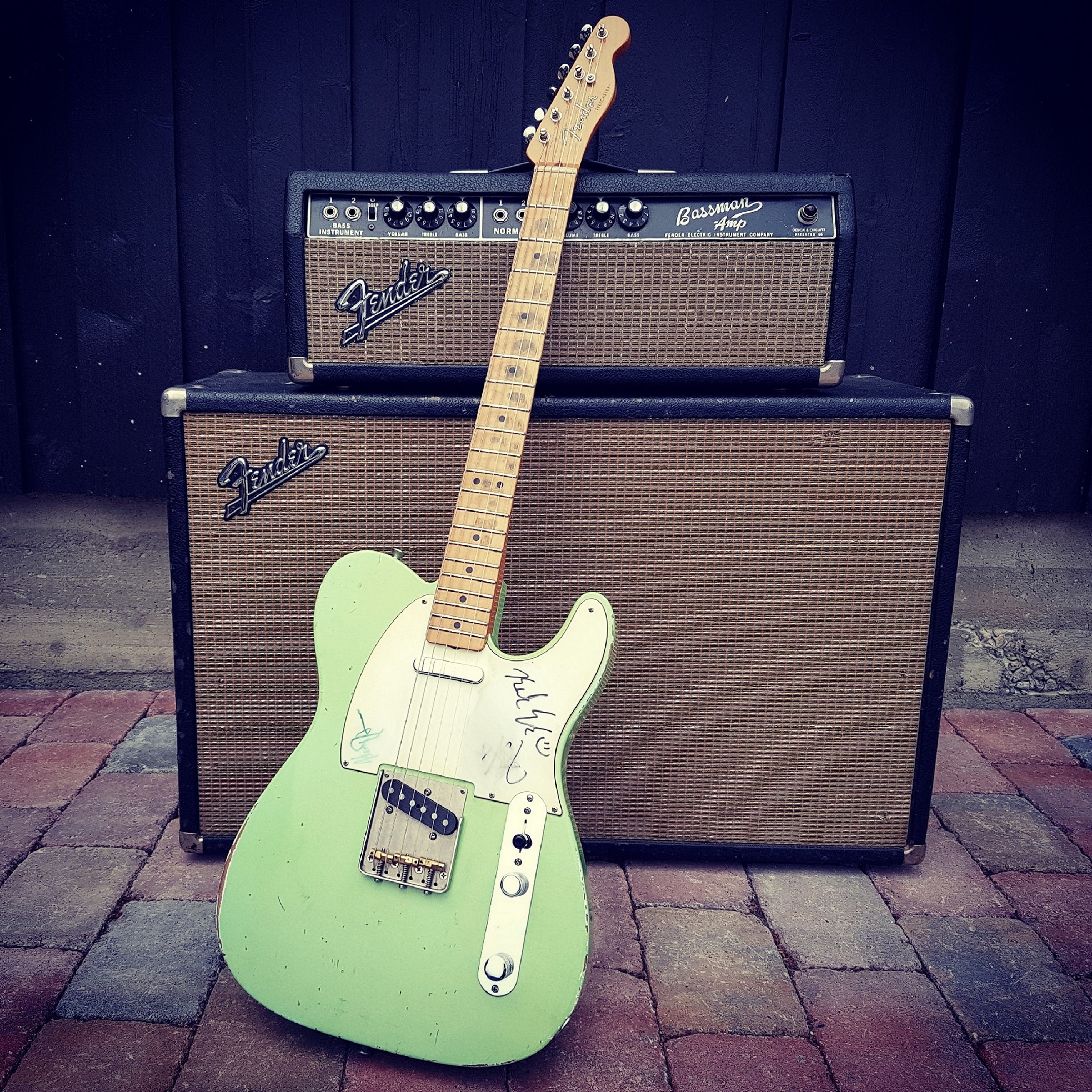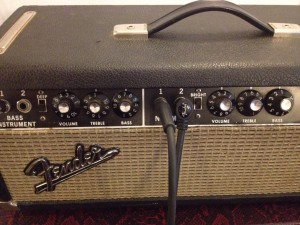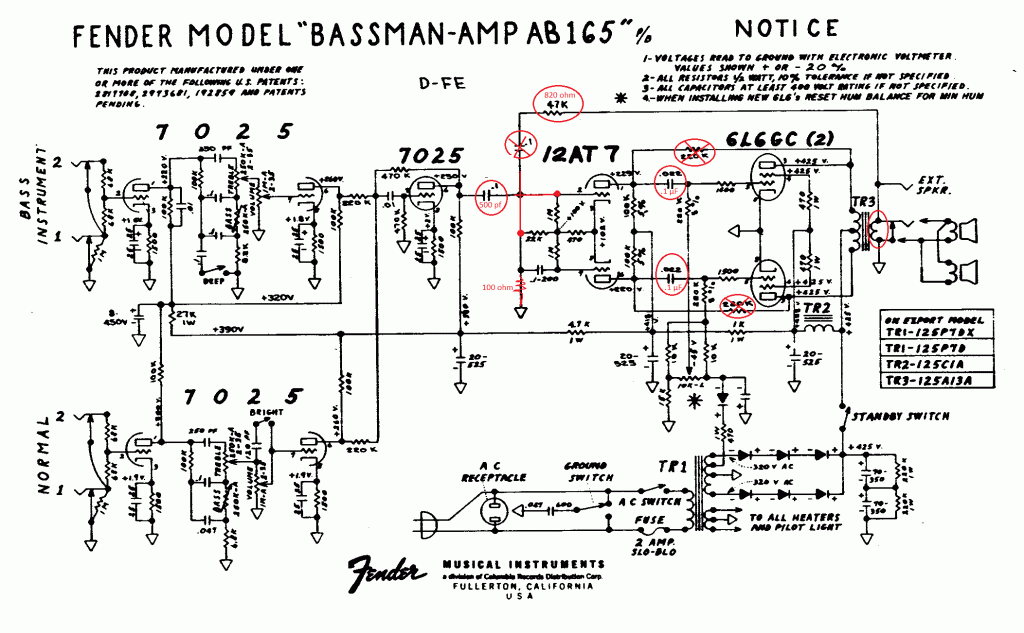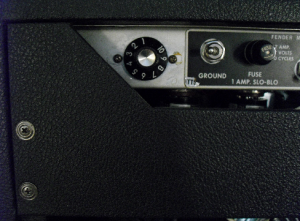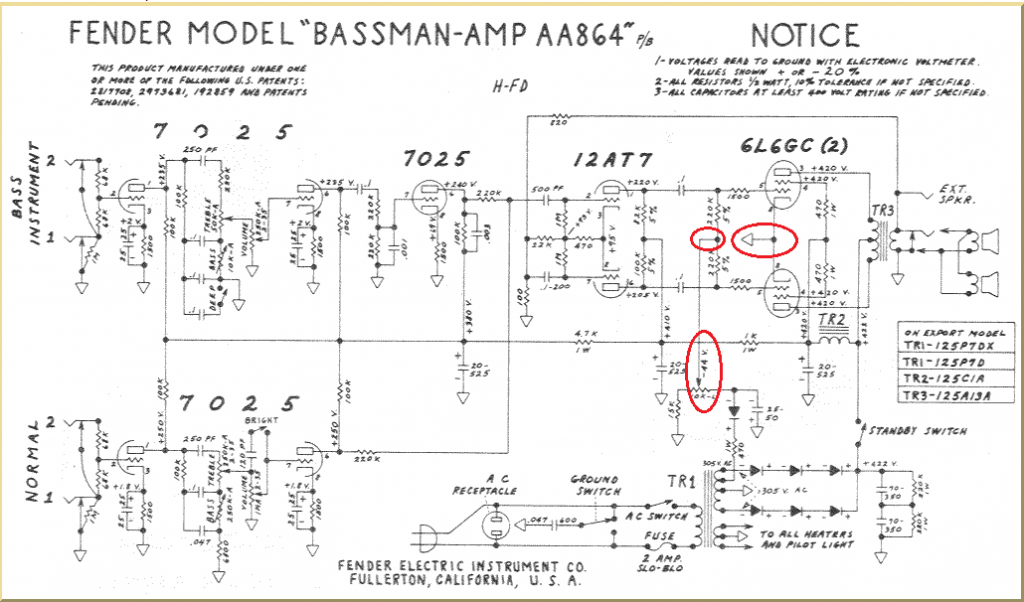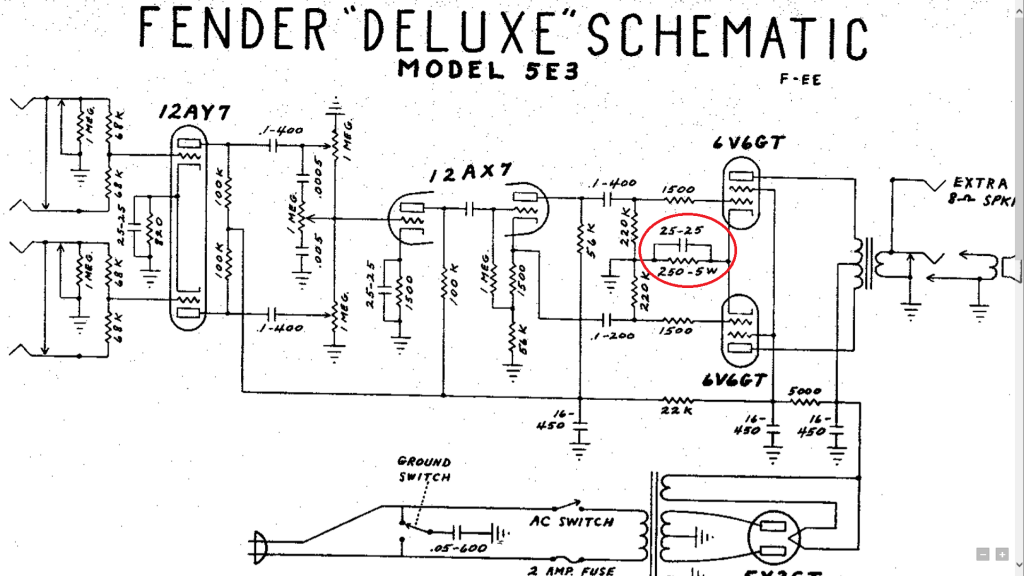Production years
1964 -1967 “blackface” circuits AA864, AA165, AB165
1967 -1977 “silverface” circuits AA165, AB165, AA270, AA371, AA568, AC568, AA864
Tube layout
AA864 Tube layout (Seen from behind, V1 is to the right side):
V1 12ax7 = Preamp bass channel
V2 12ax7 = 2’nd gain stage bass channel (and normal channel for AB165)
V3 12ax7 = Preamp normal channel
V4 12at7 = Phase inverter
V5 6L6 = Power tube #1
V6 6L6 = Power tube #2
Summary
The Fender Bassman is a legendary guitar amp known to both guitar and bass players. It was introduced in 1951, primarily targeted for bass guitar players and promoted as a bass amp for the Fender Precision Bass guitar, the first mass-produced electric bass guitar ever. During the different eras the Bassman amp came in many different shapes and configurations. Few other models experienced so many changes in terms of looks and tone. The next time you get into a Fender Bassman discussion you should narrow down exact which era, model and circuit you’re discussing. Otherwise it will just be a fool’s discussion.
The tube charts are not very useful for determining the circuit model. A lot of blackface Bassman amps with AA864 tube charts are actually AA165’s, and a lot of AA165 charts are glued into AB165 amps. At the Fender factory they used old tube charts when new models came, probably because the tube layout was the same. Determining production date by serial number and transformer codes is better, and you should also inspect the circuit to be completely sure.
The picture below shows a 1969 transition model amp.
Unfortunately the Bassman was one of the first amps that CBS laid their hands on after buying the company from Leo Fender. A couple of things in the circuitry were immediately changed in 1965 when the AA165 and AB165 replaced the AA864. Amp collectors and idealists often prefer the pre-CBS models but if we study the AB165 circuit it does have something very interesting for guitar players who enjoy cranked Fender blackface tones. We’ll come back to this later in the “blackface chapter” below where we’ll demystify some of the hypes with the popular AA864. The AA165 is very rare and its circuit and tone is quite similar to the AA864. We will further focus mostly on the AB165 vs AA864.
Some things have not changed since the beginning; The Bassman never had reverb or tremolo. All models have a push-pull (class AB) dual 6L6GC power amp configuration. Up to the blonde Bassman with blonde colored tolex (circuit 6G6) they all had tube rectifier, but since then a diode rectifier was used. The bassman was a combo amp in the tweed era with the 1×15″ and 4×10″ speaker configurations. From the blonde era Fender made the Bassman as a amp head and 2×12″ closed cabinet.
So what does the blackface Bassman sound like? The video below compares a Bassman AB165 to a Princeton Reverb and a Deluxe Reverb.
Describing the blackface Bassman tone is best done with establishing a common and well-known reference point, for example the traditional blackface AB763 amps such as the Super Reverb and Twin Reverb. The Bassman is known for its simple, pure and raw tone. It is 50w loud with power supply and output transformers sized approx. as the Super Reverb and Bandmaster. The bass channel of the AB165 and AA864 is much mellower and deeper than the normal channel of any AB763 amps since it is voiced for bass guitars. The Bassman bass channel features a deep switch that can remove the lowest frequencies, which is practical when you’re playing loud and using different speaker cabinets where you need to adjust the lower bass. The normal channel is more relevant for guitar players. The Bassman sounds “browner” than the AB763-amps, particularly the AB165 model, and it has more preamp distortion and mids when the volume is turned up. The reason that the Ab763-amps have less preamp gain is the use of only one half/triode (V4 12ax7) in the second gain stage vs both halfs/triodes (V2 12ax7) in the the Bassman AB165. The normal channel in the AA864 Bassman is cleaner than in the AB165 since it has no additional gain stage. The Bassman amps have more mids than the AB763-amps, and particularly without the reverb effect (the reverbs thins the tone) the Bassman experience is a fuller, direct and less camouflaged tone.
The Bassman circuit is simpler and has less components and tubes than other AB763 amps. A less complicated circuit means fewer things that can go wrong, less component drift issues, easier to service and less potential for noise problems. The Bassman has significantly influenced the whole guitar amp industry since it was introduced. It’s tone stack, tube configuration, preamp and power section has inspired numerous amps builders including Jim Marshall, the founder of Marshall amps, who used the Bassman tweed 5F6-A circuit in 1958-1959 as template the legendary Marshall JTM45.
As for all amps you will be able to shape your tone significantly with selecting speakers and tubes. You’ll need schematics to implement some of these mods in this page. http://ampwares.com/brand/fender. We usually start with explaining a mod from a functional perspective where we relate to components in the logical schematics diagram. Finally we point out location of components in the physical layout diagram.
Speakers
The 2×12″ closed cabinet delivers a more punchy and bassy tone than open back combos. Its powerful response is appreciated by both bass players and guitarists who play loudly with significant amount of distortion. Bass and distortion compensate each other nicely, and the Bassman will deliver lots of it. Replacing speakers is the easiest and most effective mod of them all. The speaker is the most important component in your amp which physically produces the air waves that your ears detect as a tone. See page How to select speakers for speaker recommendations.
Jumping channels
Jumping channels means that one splits the guitar signal in to both channels. This can be done by using effect pedals or simply use a jack cable between one channel’s 2’nd input and the other channels first input. Some Fender amps have the two channels out of phase due to different number of tube stages in each channel, like the AA864 and AA165 Bassman and most AB763 reverb amps. The AB165 Bassman channels are in phase and can be used together. Jumping channels that are out of phase won’t hurt the amp, but the tone is thin and weird.
Jumping channels in the AB165 Bassman will give you a wider spectrum of tones than by using just one channel. You may for example use the bass channel for the deepest bass tones and the normal channel for sparkling clean sound with bright switch on and zero bass, giving you an extremely full and meaty tone which you won’t get using just one channel. See picture below for example knob settings. We recommend a closed or semi-closed speaker cabinet for this setting. You may increase volume further for cranking the amp harder. If you use Eb or open D tuning, your Bassman will growl like a bear.
5751, 12AY7 or 12AT7 as preamp tube – Less preamp gain.
If you want a cleaner and spankier tone you can replace the V1/V2 12AX7 preamp tube with 5751, 12AT7, or 12AY7. These tubes have lower voltage gain and different frequency responses, particularly when distorting. 12AX7 tube has a voltage gain factor = 100, while 5751 = 70, 12AT7 = 60 and 12AY7 = 45. One could describe these tubes to have less harsh and buzzy distortion. This mod does not alter the tone significantly when amp is played clean’ish. You’ll have to increase the volume setting to achieve a similar volume as before. If you hit sweet spot at volume=4 with 12AX7 you may go as high as 6-7 before reaching it with a 12AT7.
Pull V1 or V3 preamp tubes
If you are a guitarist and use only the the normal channel, you can get a slight increase of preamp gain (and volume on a given knob setting) by pulling the V1 bass channel preamp tube. You’re not using this tube if you play the normal channel. Vice versa; If you’re using only the bass channel, you can pull out the V3 tube, the preamp tube of the normal channel. The effect is strongest in the bass channel and in the normal channel of the AB165 model since a stronger signal will push the second gain stage (V2 tube) harder with even more sustain, compression and harmonics added.
The preamp tube circuit in the blackface Bassman is not similar to the AB763-amps. In the AB763 amps you will achieve more preamp gain with pulling the other channel’s preamp tube. The reason is that the V1 and V2 tubes share the cathode cap and resistor (25 uF/1500 ohm) and pulling one of the tubes will changes the effective value of the resistor they both share. This results in a hotter bias for the remaining preamp tube. However, there is still a noticeable effect in the Bassman since pulling a preamp tube reduces the current draw from the power transformer and the plate voltage (B+) on remaining preamp tubes will increase.
This mod does not change the amp’s clean headroom. If one experiences more noise with pulling one tube, we suggest to put it back. Ideally one should ground some of the floating pins in the open tube socket.
Replace the 12AT7 PI tube with a 12AX7 or 12AU7 – Less clean headroom.
Very practical mod at practice and low volume environments. This mod reduces the amp’s clean headroom and you’ll achieve sweet spot at a lower volume. You’ll notice that the amp gets looser and with less attack. Tips: If you pulled the V1 or V3 12AX7 tube you may use it as V4 phase inverter.
12AX7 as phase inverter tube will give the most effect out of this mod. 12AU7 will be in between 12AT7 and 12AU7.
Blackfacing
The 1964-65 AA864 circuit/model has been very popular among by ampoholics, collectors and idealists. It was Leo Fender’s original blackface Bassman circuit design. Not only was it simple and robust, it delivered pure, fat and sparkling Fender blackface tone. The AB165 model came with a couple of “CBS tweaks” after the takeover in 1965. Some say the changes were unfortunate, but there are many players who find the AB165 tone to be equally good, if not better. CBS Fender made an interesting move with the AB165 wiring the normal channel so that is also uses second preamp tube (V2 12ax7), just like the Bass channel does in both AA864 and AB165. The previous AA864 only used one preamp tube V3 before the phase inverter. And unlike the AB763-design where just one half of a tube is used, both halfs/triodes are used in the AB165 Bassman. This means that the AB165, if turned up, will have more breakup, compression and sag than the AA864 Bassman and the AB763-amps. Who doesn’t appreciate these things?
The power amp section of the AB165 got a couple of bad tweaks. One is the stupid, unbalanced bias circuit and a strange implementation of the strange negative feedback loop which was never seen in any Fender amp before or after. The bias setup will not affect the tone as long as you are lucky and able to find a sweet bias spot with a set of tubes. But the negative feedback will. However, the most noticeable change in the AB165 was introducing a gain stage in the normal channel.
What can we possibly draw from this knowledge with the AB165 and AA864? Is there any point in doing a blackface converting of silverface amps? We’d say not really. The blackface AB165 and silverface AA270 have great tone as it is. If you are really interested in blackfacing or modding your Bassman, you should read the next chapter first.
fenderguru.com Hot rodded Blackface Bassman
At fenderguru.com we have come up with a Bassman design where you get the best from both the AA864 and AB165. Additionally we apply a couple of mods to get more compression, sag and breakup at lower volumes. We call this amp “The fenderguru.com Hot rodded Blackface Bassman”. It can deliver pure, clean blackface tones as well as roaring, cross-Atlantic Marshall tones. The fenderguru.com Hot rodded Blackface Bassman is based on the AB165 circuit design with a couple of AA864-tweaks. An essential ingredient is disabling the negative feedback loop (make it switchable) and convert to cathode bias on the 6L6. We also add a 10K mid pot on the back of the amp (described further down in this article). Simply explained, this amp is a Fender Marshall crossover amp. The steps are explained below.
The youtube video below demos this amp:
1) Combining the AB165 and AA864
The schematics for this amp is explained below. The red circles in the schematic below illustrates these changes. From right to left:
– Switch the polarity of the two wires coming from the output transformer going to the speaker terminals. You need to do this only if you change the negative feedback loop to AA864 specs.
– Remove the 220k feedback resistors from each of the plates on the two 6L6 tubes. You will get more breakup and distortion and more volume at a given volume knob setting.
– Replace the 0.022uF coupling caps in front of the 6L6 to 0.1uF.
– Modify the negative feedback loop from the AB165-design to the AA864/standard Fender NBF design. Remove the 0.1uF cap and 47 KOhm resistor in the feedback loop and replace with a 820 ohm resistor (which you can make switchable by using the ground switch). Personally we have experienced good results with a 1.5K which reduces the negative feedback and increases distortion and treble. The .1uF cap you are about to remove may be used later as coupling cap between phase inverter and power tubes. The negative feedback loop ends up at the left side of the 22 kOhm resistor which is a new soldering point.
– You need to insert a 100 ohm resistor between the left side of 22 kOhm resistor to ground (the new entry point of the neg feedback loop in previous step).
– Between the second preamp tube (V2) and the phase inverter circuitry, replace the 0.1uF coupling cap with a 500 pF.
(click on image to view full size)
2) Negative feedback loop
The negative feedback loop can easily be tweaked to alter the treble cut and distortion in your amp. The purpose of the NBF loop is to clean up the tone and cancel out the mid/higher frequencies and upper harmonics (distortion) at the entry point of the phase inverter which is placed in front of the power tubes. The NBF theory is that you take the signal from the speaker output, let it go through a resistor and mix it in at the entry point of the phase inverter. The speaker signal is out of phase (180 degrees) with the signal at the entry point of the phase inverter and will cancel out equal frequencies. If you disconnect the NBF loop you’ll notice that the volume increases and tone gets much more aggressive. More white noise too. unfortunately, which is why there is a NFB loop. You will fin the amp’s sweet spot at a lower volume knob setting without the NFB loop. Not only is there a volume shift, the amp’s clean headroom is reduced slightly. Most importantly the tone gets rougher and rawer with more mids and higher frequencies, aka presence. If you think your tone is too bright or harsh or you’re seeking a mellow and nice clean tone, you probably want to keep the NBF loop. This mod is for those who want more bite and a tone that really cuts through in the mix.
You may choose to implement the mod in several ways and in various combinations with the ground switch or a foot pedal. A foot pedal works like a boost/FAT pedal. If yo’re struggling to find a transparent boost pedal that keeps the natural Fender tone you should try this out. You will still have that beautiful Fender tone, just more and wilder.
- No negative feedback at all. Simply disconnect the feedback loop (a wire) and tape insulate it. You get the most effect of this mod by disconnecting the NFB loop entirely. You may experience that the tone gets harsh, depending on guitar, speakers and EQ settings of course. If so, read more about the cap in the next bullet point.
- Keep the feedback loop and install a .01 µF in series with the NBF resistor. This cap will prevent the lower and mid frequencies to go through the NFB loop. Depending on the cap value treble frequencies will be fed back to the phase inverter which cancels out the treble in the main path. The tone gets less harsh and you still have a noticeable effect. You should experiment with different cap values. Start with 0.01µF.
- Increase the feedback loop resistance value. A good starting point is twice the original resistor value. This reduces the effect of the feedback loop, making the amp break up more when the NFB is engaged. If you make the NBF switchable there will be less volume difference if you use a high resistor value. (Using a .01 µF cap is also recommended to minimize the difference a little bit between NBF on and off).
- Use the ground switch or foot pedal to make the NBF switchable. If you remove the death cap and free up the ground switch by removing existing wires to it (if you’re wondering what the ground switch does, you don’t need it). Then wire the ground switch in series with the NBF resistor. If you’re using a cap in the NBF loop this goes across the switch allowing treble to bypass independent of the switch. When the ground switch has disconnected the NBF loop the higher frequencies are still fed back through the cap. In practice you solder each the two cap legs to at each side of the switch between speaker terminal and NFB resistor.
Where to install foot-pedal or switch? The ground switch is easy available if you disable the power supply wires and death cap. For amps with reverb you could use the reverb footswitch phono plug if you are not using it.
3) Middle pot
The Bassman came without a mid pot. Many players are happy with the default 6.8K mid resistor in the EQ circuitry, but if you replace it with a 3 KOhm resistor and wire a 10K pot in series you’ll get a much wider selection of tones at your hands. You may go from a scooped, clean blackface tone to burning British, Tweed or Brownface tone. When the mid is turned up you’ll experience that the amp breaks up a lot more and growls like a bear. You may install the mid pot at the left most side of back of the amp where the additional power supply is located. You can also use the reverb footswitch phono plug if you, like most players, never switch off the reverb with the footswitch.
4) Converting to cathode bias
The power amp section of the blackface and silverface Bassmans are all fixed bias circuit designs, as well as for almost every 6L6 Fender amp. The cathode of the 6L6 power tubes is grounded. Hence, the voltage is fixed at zero. Having a fixed bias means, contradictionary perhaps, that you need adjust the bias current (or voltage) by using a bias pot. When the bias current/voltage is properly adjusted the tubes are operating at a safe operating point with good efficiency. Unlike fixed bias you don’t have to adjust the bias manually in the cathode bias design. It is self-adjustable. The bias is in fact adjusted continuously according to how much power the tubes are delivering and how much current is flowing from the cathode to ground. The more current that is flowing, the higher cathode voltage. In terms of tone this means that the clean headroom is reduced and most importantly, you get more compression and sag at both clean and cranked volume levels. There is less attack and a more sweet and forgiving tone. This can be desirable for those who have a hard pick attack.
Converting to cathode bias in the blackface and silverface Bassman circuits, and other Fender amps with fixed bias, is very simple. It is in fact so simple that we recommend everyone to try it. Personally we prefer cathode bias in big, powerful amps with big transformers where you have more than enough power and attack.
The schematics below show the AA864 Bassman and the narrow panel Tweed 5e3 Deluxe. We think that the cathode bias circuit design of the 5e3 works very well in the Bassman.
- In stead of grounding the 6L6 cathodes, insert a parallel-coupled 250 ohm/ 5w resistor and 25µF/50V cap between ground and the two cathodes.
- Disengage the wire going to the bias pot middle lug and solder it to ground. You can simply let the bias pot circuitry stay where it is in case you want to roll back the changes (or make it switchable between fixed and cathode bias).

